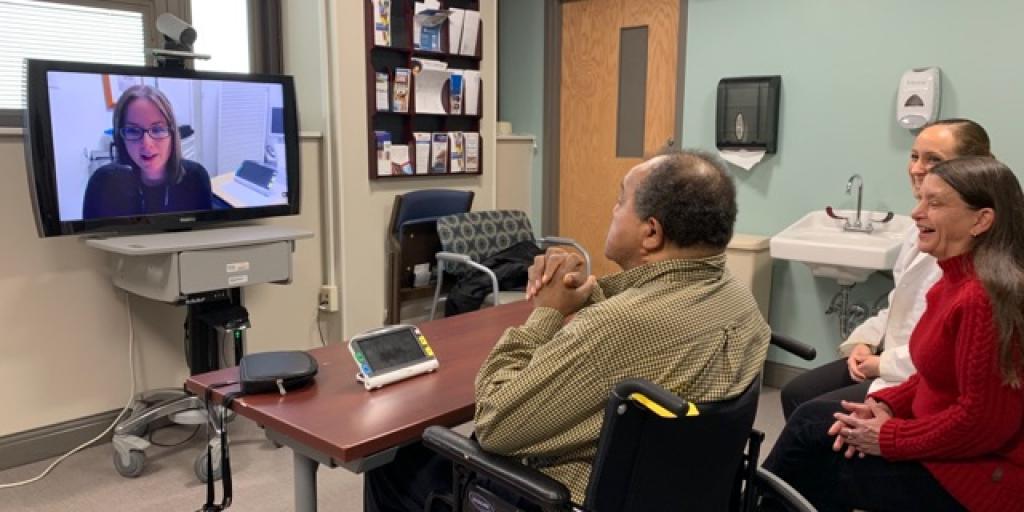High Standards for Low Vision Health – VA Pittsburgh Expands Virtual Care Services for Veterans

VA Pittsburgh Healthcare System (VAPHS) now uses telehealth to provide Veterans with close-to-home low-vision rehabilitation, a service many have found to be invaluable during COVID-19. It allows Veterans who cannot travel to Pittsburgh to receive care in their own homes or at nearby VA clinics.
Low-vision rehabilitation benefits Veterans whose glasses no longer help them, or who are diagnosed with age-related macular degeneration, glaucoma, diabetic retinopathy or other conditions. Care begins with a holistic approach to maximize remaining vision so Veterans can achieve goals such as seeing food on a plate, signing a check, watching television or reading.
In-Home Care with Telehealth
Veterans William Bowling and Dennis Serrano both receive in-home, low-vision care through telehealth.
Bowling, 94, enlisted in the Navy in November 1944 before graduating high school. He trained in Amarillo, Texas, as a mechanic for B-17 and B-29 bombers as World War II was winding down in Europe.
A Washington, Pennsylvania, resident, Bowling has received low-vision care at VA Pittsburgh Healthcare System (VAPHS) since 2018. VAPHS recently provided him with equipment for the telehealth visits and had a blind rehabilitation specialist visit his home to ensure he understands how to use it.
“I just can’t say enough about the service,” said Bowling. “It’s just been great. They gave me all kinds of equipment. I couldn’t read anything, and now I can.”
Serrano, 91, served with the Army during the Korean War as a radar technician. After transitioning out, he worked as an Air Force contract engineer on simulation devices for over 20 years.
Born and raised in Pittsburgh, Serrano relies on public transportation to VAPHS for appointments, including low-vision care. Since COVID-19 restrictions, he’s begun using telehealth from his home.
“I personally think this system is excellent,” said Serrano. “I don’t have to worry about the bus schedule, and I get to talk face to face with my doctors and everyone. I enjoy it.”
He said the in-home therapy allows him to maintain his independence.
“I do everything on the computer, my banking, pay my bills, shop for items I might need,” said Serrano. “I try to do as much as I can on my own. This gives me a sense of independence that I can do things for myself.”
The telehealth visits also provide healthy social interactions for Veterans who might feel isolated at home during COVID-19.
Clinical Video Telehealth Helps Erie and Clarksburg Veterans
Using Clinical Video Telehealth (CVT), Veterans in Erie and Clarksburg, West Virginia, can now receive low-vision care without having to travel to VA medical centers in Pittsburgh, Cleveland or Buffalo. CVT uses real-time, secure interactive video conferencing to provide care to Veterans remotely. It typically links a patient at a clinic to a VA provider in another location.
Veterans in Erie and West Virginia connect in real time with a VAPHS low vision occupational therapist to learn visual skills, adaptations and modifications for daily living activities. Patients with macular degeneration learn how to shift their eyes to maximize remaining vision, a skill known as “eccentric viewing.” Veterans also learn how to use optical and electronic magnification devices combined with practical techniques to reach their goals.
“It takes a village to do this,” said Amy Rebovich, a VAPHS low vision occupational therapist who provides the therapy via CVT. “It’s really exciting that this has been working so smoothly. Veterans love it.”
Rebovich said Clarksburg Veterans who need rehabilitation services are “thrilled at the prospect” of using CVT so they don’t have to travel to Pittsburgh or Washington in Pennsylvania or Martinsburg, West Virginia.
In Erie, VA optometrist Dr. Delia Landy said using CVT to provide low-vision rehabilitation is proving to be beneficial to Veterans.
“It’s wonderful to provide a service to our Veterans where I can begin teaching them a concept during their exam,” said Landy, director of Erie VA’s Optometry Resident and Low Vision programs. “Then Amy can really solidify the information with the Veteran and give them homework to practice using their eyes in unique ways to maximize their remaining vision.”
Landy’s teammate, Laryssa Stolar, visual impairment service team coordinator, was excited to see the progress.
“Erie and Pittsburgh broke down the silos and to become ‘one VA’ and meet the needs of our low vision Veterans,” Stolar said.
The pandemic has brought to light Veterans’ critical need for socialization when pursuing vision goals. Veterans, especially those with vision loss, sometimes feel isolated, which can affect emotional and mental health, and sometimes motivation.
Rebovich said despite all the uncertainty during the pandemic, low-vision limitations and other personal challenges, her Veteran patients have been adaptable and motivated to embrace a new care method.
“The most important part is Veterans can stay at home,” said Rebovich. “I’m really proud of our Vets, and many are in their 80s and 90s. They can stay safe, especially during the pandemic, and still get the excellent care they deserve.”
To learn more, talk to your primary care provider or call 412-822-2125.
